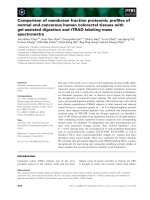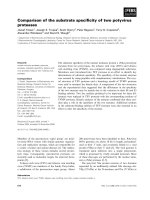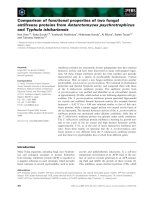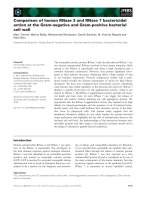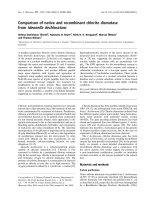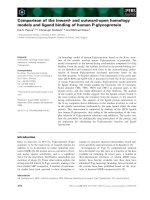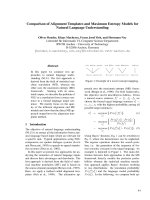Báo cáo khoa học: "Comparison of different bronchial closure techniques following pneumonectomy in dogs" doc
Bạn đang xem bản rút gọn của tài liệu. Xem và tải ngay bản đầy đủ của tài liệu tại đây (1.74 MB, 7 trang )
JOURNAL OF
Veterinary
Science
J. Vet. Sci. (2007), 8(4), 393
399
*Corresponding author
Tel: +90-224-233-5384; Fax: +90-224-234-6395
E-mail:
Comparison of different bronchial closure techniques following
pneumonectomy in dogs
Hakan Salci
1,
*
, A. Sami Bayram
2
, Ozgur Ozyigit
3
, Cengiz Gebitekin
2
, O. Sacit Gorgul
1
1
Department of Surgery, Faculty of Veterinary Medicine,
2
Department of Thorax Surgery, Faculty of Medicine and
3
Department of Pathology, Faculty of Veterinary Medicine, Uludag University, Bursa, Turkey
The comparison of the histologic healing and broncho-
pleural fistula (BPF) complications encountered with
three different BS closure techniques (manual suture, sta-
pler and manual suture plus tissue flab) after pneumo-
nectomy in dogs was investigated for a one-month period.
The dogs were separated into two groups: group I (GI) (n
= 9) and group II (GII) (n = 9). Right and left pneumo-
nectomies were performed on the animals in GI and GII,
respectively. Each group was further divided into three
subgroups according to BS closure technique: subgroup I
(SGI) (n = 3), manual suture; subgroup II (SGII) (n = 3),
stapler; and subgroup III (SGIII) (n = 3), manual suture
plus tissue flab. The dogs were sacrificed after one month
of observation, and the bronchial stumps were removed
for histological examination. The complications observed
during a one-month period following pneumonectomy in
nine dogs (n = 9) were: BPF (n = 5), peri-operative cardiac
arrest (n = 1), post-operative respiratory arrest (n = 1),
post-operative cardiac failure (n = 1) and cardio-pulmo-
nary failure (n = 1). Histological healing was classified as
complete or incomplete healing. Histological healing and
BPF complications in the subgroups were analyzed statis-
tically. There was no significant difference in histological
healing between SGI and SGIII (p = 1.00; p
>
0.05), nor
between SGII and SGIII (p = 1.00; p
>
0.05). Similarly, no
significant difference was observed between the subgroups
in terms of BPF (p = 0.945; p
>
0.05). The results of the
statistical analysis indicated that manual suture, stapler or
manual suture plus tissue flab could be alternative meth-
ods for BS closure following pneumonectomy in dogs.
Key words: bronchial closure, bronchial stump, dog, pneu-
monectomy
Introduction
Pneumonectomy is a lung resection technique that has
been used to remove all lung lobes in humans and dogs
when bilobectomy or lobectomy techniques are inadequate
to remove the pathology in the hemi-thorax [12,13,23,32].
In dogs, pneumonectomy has been performed in some
pathological conditions, such as lung tumors, congenital
lung anomalies, chronic lung collapse, chronic progressive
lung inflammation, post-traumatic diffuse parenchymal
laceration, and bronchial rupture [12,23,25].
The reported morbidity and mortality rate after pneumo-
nectomy is extremely high in humans suffering from respi-
ratory, cardiac and gastrointestinal system problems, acute
respiratory distress, pneumonia, pulmonary edema, pul-
monary thromboembolism, bronchopleural fistula (BPF),
pyothorax, esophagopleural fistula, cardiac herniation,
lung lobe torsion, hemathorax and chylothorax [13,23,32].
The most commonly encountered complication of pneu-
monectomy in humans is BPF, which is described as a
pathologic connection between the bronchus and pleural
space [2,3,18,19,21,31-33,36]. Closure failure of the bron-
chial stump (BS) after partial or complete lung resection is
the primary cause of BPF in humans, leading to a pro-
longed hospitalization period and the need for multiple op-
erations [1,11,16-18,19,21,31-34,36]. Some authors [1,3,
8] have reported of the incidence of BPF to be in the range
of 0-28%, while others [19,21,31,32,34,35,37] have re-
ported the incidence to be between 0% and 12%. The mor-
tality rate of BPF has been reported to be between 15% and
70% [8,10,14,16,18-20,37]. Pneumonia, pleural infections
and failure in BS closure are the primary risk factors for
BPF [1,11,17,19,32]. The proper BS closure technique to
prevent BS dehiscence after pneumonectomy has been
long debated in the field of human thoracic surgery
[3,17,31]. Therefore, the stapler technique has been used to
prevent BPF in humans and dogs [1-3,17,22]. There seems
to be no consensus between researchers regarding the opti-
394 Hakan Salci et al.
Tabl e 1. Distribution of operations in groups evaluated histologi
-
cally, and the number of complications and operations in each
subgroup
Subgroups
Evaluated
histologically
Number of
complications
GI GII
SGI (n = 10)
SGII (n = 7)
SGIII (n = 10)
3
3
3
3
3
3
4
1
4
Total (n = 27) 9 9 9
GI: group I (right pneumonectomy), GII: group II (left pneumo-
nectomy), SGI: subgroup I (manual suture), SGII: subgroup II
(stapler), SGIII: subgroup III (manual suture plus tissue flab).
mal method for BS closure because several authors have
made different suggestions for this procedure [1,6,8,11,
19,21].
The surgical procedures for BS closure are focused on su-
ture line (transversal versus longitudinal), suture technique
(manual versus mechanical), clamping technique (open
stump technique versus closed stump technique) and
whether or not to wrap the BS (e.g. pleuralization, flap)
[18,32].
Both manual (by running or interrupted suture) and me-
chanical sutures have been routinely used in humans and
dogs [6,12,15,18,22,26,30]. The superiority of both meth-
ods has been clearly demonstrated by incidence of BPF
complications in humans [1,18,20]. In recent years, the au-
togenic tissue wrapping of the BS after pneumonectomy
has been reported to decrease the incidence of BPF
[1,10,21,28,31,34]. Therefore, in this technique the inter-
costal muscle flaps are primarily used to support the vascu-
larity of the BS and the line of anastomosis in the trachea.
In addition, the popularity of intercostal muscle flap usage
has been increased in human thoracic surgery due to their
thickness, autogenous and self-vascularization properties
[9,27,37].
In the present study, this literature data was compared
with the histologic healing and BPF complications en-
countered following three different BS closure techniques
(manual suture, stapler and manual suture plus tissue flab)
after pneumonectomy in dogs were evaluated for a period
of one month.
Materials and Methods
Experimental group
A total of 27 hybrid dogs (two years old, 20 kg in weight
and sex was not considered) were used in this study.
Histological healing was evaluated in 18 dogs (n = 18);
nine dogs (n = 9) were reviewed separately due to post-
operative complications. The 18 dogs were separated into
two groups: group I (GI) (n = 9) and group II (GII) (n = 9).
Right and left pneumonectomies were performed in the
dogs in GI and GII, respectively. The dogs in GI and GII
were further divided into three subgroups [subgroup I
(SGI) (n = 3), subgroup II (SGII) (n = 3) and subgroup III
(SGIII) (n = 3)] according to the BS closure technique
performed. The main stem bronchus was closed with a
manual suture in subgroup I (SGI) (n = 3), with a stapler in
subgroup II (SGII) (n = 3), and with a manual suture plus
tissue flab (pedicled intercostal externus-internus muscle)
in subgroup III (SGIII) (n = 3) following pneumonectomy
(Table 1).
The dogs were anesthetized and continued with 2% iso-
floran after the administration of xylasine HCl (1 mg/kg
IM) and thiopental Na (15 mg/kg IV). Respiration was en-
sured by mechanical ventilation (15 ml/kg tidal volume,
respiration rate 15/min and 25 cm H
2
O alveolar pressure).
All BS closures were carried out by the same surgical
team as described previously. Thoracotomy incision was
made on the 4th intercostal space according to the standard
procedure in the SGI and SGII groups, but the 4th inter-
costal externus - internus muscle prepared as a pedicled
flap in the SGIII group. The main stem bronchus was dis-
sected after ligation of the pulmonary arteries and veins.
Pneumonectomy was carried out using the open bronchi
resection technique in groups SGI and SGIII. In SGII,
however, resection was performed after stapler closure.
Bronchial closure
Subgroup I (manual suture): Vertical mattress sutures
were applied over the excision line, and the end of the
stump was sutured with a simple interrupted suture pattern
using 2-0 vicryl (Ethicon, UK) (Fig. 1A).
Subgroup II (stapler): A TA-30 stapler (Ethicon, UK) (4.8
mm) was initially applied to the main stem bronchus, and
the bronchus was then excised (Fig. 1B).
Subgroup III (manual suture plus tissue flab): Pedicled in-
tercostal externus-internus muscle was extended towards
the BS and then wrapped and sutured using a simple con-
tinuous suture pattern with 2-0 vicryl after manual suturing
of the BS with 2-0 vicryl (Fig. 1C).
The pleural space was filled with warm sterile saline, and
then 50 cm H
2
O endobronchial pressure was applied to de-
termine the bronchial air leakage. Extra vertical mattress
suture(s) was/were applied over the excision side of the BS
in cases where air bubbles occurred due to the BS. Saline
was aspirated, and a 28-French thoracostomy tube (Argyle,
USA) was inserted into the pleural cavity ventro-cranially.
The tube was fixed to the skin with a 'Chinese finger trap'
suture pattern, and a Heimlich flutter valve was connected
to the tube for pleural drainage.
Comparison of bronchial closure techniques in dogs 395
Fig. 2. (A) Mediastinal shift observed on the 15th postoperative
day on a ventrodorsal radiograph of a dog with right pneumo-
nectomy. h: heart. (B) This postmortem ventro-dorsal radiograp
h
shows tension pneumothorax and subcutaneous emphysema (ar-
row) in a dog with BPF.
Fig. 1. (A) Suture closure of the main stem bronchus (arrow) with
2-0 vicryl following pneumonectomy. (B) Application of a
TA-30 stapler to the main stem bronchus after pulmonary artery
and vein ligation. (C) Transposition and suturing of the 4th inter
-
costal muscle flap (arrow) to the main stem bronchus following
p
neumonectomy.
Tabl e 2 . Encountered complications and their total numbers in
each subgroup after pneumonectomy
Subgroup
Total number of
complications
Encountered complication
SGI
SGII
SGIII
4
1
4
BPF (day 10)
BPF (day 5)
Cardiac failure (day 15)
Respiratory arrest (in 1st hour)
BPF (day 5)
BPF (day 15)
BPF (week 1)
Peri-operative cardiac arrest
Cardio-pulmonary failure
(week 3)
BPF: Bronchopleural fistula, SGI: subgroup I (manual suture),
SGII: subgroup II (stapler), SGIII: subgroup III (manual suture
p
lus
tissue flab).
Postoperative care was carried out in compliance with the
rules of the National Society of Medical Research
Principles of Laboratory Animal Care for a period of one
month. The dogs were relieved with carprofen (5 mg/kg/d
SC). Cefazolin Na (20 mg/kg IV tid) was used as an anti-
biotic agent for 5 days. Lactate ringer and hetastarch sol-
utions were infused for postoperative fluid therapy.
Hematologic parameters and blood gas analysis of the dogs
were controlled routinely, and the dogs were closely moni-
tored for suspected cardiac problems and respiratory fail-
ure after pneumonectomy. The dogs were checked radio-
logically in cases of suspected respiratory insufficiency.
The thoracostomy tube and skin sutures were removed on
days 5 and 7 after surgery, respectively. At the end of the
postoperative first month, the dogs in GI and GII were sac-
rificed with high-dose thiopental Na. The BS was removed
from each animal, fixed in 10% neutral-buffered formalin
and then embedded in paraffin. Five micrometer thick sec-
tions from these samples were placed on slides and stained
with hematoxylin and eosin for microscopic examination.
Statistical analysis was carried out using Fisher's exact
test and Pearson's chi-square test to determine the differ-
ences between subgroups in terms of histological healing
and BPF complications, respectively.
Results
Bronchial closure
Postoperative ventrodorsal and lateral radiographs
showed no signs of intra-thoracic pathology, such as pneu-
mothorax or hemathorax, in the dogs during a one-month
period following pneumonectomy. Mediastinal shifts were
observed in the ventrodorsal radiographs of all the dogs
(Fig. 2A); however, no abnormal clinical condition due to
mediastinal shift was observed.
h
A B A B
C
396 Hakan Salci et al.
Fig. 3. Bronchial dehiscence as a necropsy finding of a dog with
BPF. bs: bronchial stump, m: pedicled intercostal externus- inter
-
nus muscle.
Fig. 4. (A) Granulation tissue formation and continuing phagocytosis of the suture material in subgroup I (manual suture). (B)
Granulation tissue around the BS and stapler particles surrounded by macrophages in subgroup II (stapler). (C) Granulation tissue form
-
ing around the BS covered with muscle tissue in subgroup III (manual suture plus tissue flab). gt: granulation tissue, m: muscle tissue,
mc: macrophages, s: suture material, sp: stapler particles, arrow: new vessel formation. H&E stain, ×200 (A&C), ×100 (B).
Complications were encountered in 9 of the 27 dogs (10
dogs in SGI, 7 dogs in SGII and 10 dogs in SGIII) and in-
cluded two BPFs (on the 5th and 10th day), one post-
operative cardiac failure (15th day) and one postoperative
respiratory arrest (1st h after surgery) in the SGI group; one
BPF (5th day) in the SGII group; and two BPFs (on the 1st
week and 15th day), one cardio-pulmonary failure (on 3rd
week) and one peri-operative cardiac arrest in the SGIII
group (Table 2). Respiratory arrest and sudden onset of
death were typically seen in the dogs with BPF. Tension
pneumothorax and subcutaneous emphysema were ob-
served in the postmortem radiographs of these animals
(Fig. 2B). Necropsy of the dogs supported these findings
and revealed bronchial dehiscence (Fig. 3) and atelectatic
lung lobes.
In SGI, necropsy on the dog that died on the 15th day re-
vealed myocardial petechial hemorrhagic spots related to
the cardiac failure. In a different dog in SGI, the cause of
the postoperative respiratory arrest (1 h after surgery) was
insufficient lung volume, which caused the postoperative
SPO
2
value of the dog to decrease. In SGIII, alveolar em-
physema, pneumonia and petechial myocardial hemor-
rhage were seen macroscopically in the dog with car-
diopulmonary failure that died during the 3rd week after
surgery. Peri-operative cardiac arrest after left pneumo-
nectomy was seen as a complication in one of the dogs in
SGIII. This was related to an underlying cardiac problem,
which was determined to be an atrioventricular blockage
and sinus pause after pneumonectomy based on the results
of ECG.
Histological findings
Subgroup I (manual suture): Histological examinations
revealed complete healing in 4 out of 6 bronchial stumps.
Granulation tissue formation with new vessel formations
as well as continued phagocytosis of the suture material
was seen around these 4 bronchial stumps (Fig. 4A). Of the
two remaining bronchial stumps, one had severe neu-
trophil infiltration, and the other had severe neutrophil in-
filtration along with purulent bronchitis. The healing rates
of these two samples were considered to be incomplete.
Subgroup II (stapler): In the histological examination,
complete healing was seen in 4 of these 6 bronchial stumps.
New granulation tissues were seen around the BS and sta-
pler particles were surrounded by macrophages and were
being phagocytosed (Fig. 4B). There were no negative tis-
sue reactions in the regeneration lesions. The other two
samples had diffuse and severe hemorrhages in the re-
generation area, and their healing was considered to be
incomplete.
Subgroup III (manual suture plus tissue flab): Complete
healing was observed in 3 out of 6 bronchial stumps. The
S
S
S
S
S
S
S
S
S
S
gt
gt
gt
gt
gt
gt
gt
gt
gt
mc
mc
mc
mc
sp
sp
sp
m
m
m
m
m
m
m
gt
gt
gt
gt
gt
gt
A B C
m
bs
Comparison of bronchial closure techniques in dogs 397
Tabl e 3 . Numbers of complete and incomplete histological heal-
ings and BPF complications in each subgroup*
Sub-
groups
Histological healing
results
Post-operative BPF results
complete incomplete encountered not encountered
SGI
SGII
SGIII
4
4
3
2
2
3
2
1
2
8
6
8
*Abbreviations are the same as Table 1.
muscle flap used for BS closure was degenerated and nec-
rotized to a great extent, and a granulation tissue forming
around the BS covered the area (Fig. 4C). Several side-
rocytes together with small hemorrhage areas were seen.
The suture material was largely phagocytosed and phag-
ocytic activity was in a continuum. In 2 of the 3 incomplete
bronchial stumps, severe neutrophil infiltrations and se-
vere hemorrhage were observed. The numbers of complete
and incomplete histological healings and BPF complica-
tions within the subgroups are presented in Table 3.
There were no statistically significant differences in his-
tological healing between the SGI and SGIII groups (p =
1.00; p > 0.05), nor between the SGII and SGIII groups (p =
1.00; p > 0.05). Similarly, there were no significant differ-
ences in BPF complications between the SGI, SGII and
SGIII groups (p = 0.945; p >0.05).
Discussion
Respiratory, cardiac and gastrointestinal system compli-
cations are commonly observed after pneumonectomy in
humans. The prevention and treatment of these complica-
tions are important topics in thoracic surgery. A consid-
erable number of retrospective studies have been per-
formed on bronchial closure techniques in human medi-
cine, and a few experimental studies have been carried out
on the basis of these retrospective studies [29,35].
However, BS closure techniques, their histological healing
patterns and possible cardiac, respiratory and gastro-
intestinal system complications after pneumonectomy
have not been compared experimentally and have only
been reviewed in dogs [23].
Several techniques have been described for BS closure in
humans [3,18,21,29]. Of these techniques, manual suture
has been shown to be a safe and cost-effective technique
[2,12,18]. The superiority of stapler suture to manual su-
ture remains questionable, and several recent studies have
compared the stapler with manual suture techniques
[3,6,10,15]. Therefore, in the present study, manual and
stapler suture techniques were used in the SGI and SGII
groups, respectively. Manual suture, stapler and BS cover-
ing with flaps after manual suture closure are still in use to-
day [3,6,8,12,18,22,23,29,30,33,34]. Pleural flaps, patch
with pedicle, pericardial grafts, pericardial fat pad grafts,
diaphragm, azygous vein, pericardiophrenic pedicles, me-
diastinum and transposition of extra-thoracic muscles
(intercostal, serratus and latissimus dorsi) have been used
as flaps in human thoracic surgery [4,5,21,29,31,34,
35,37]. Intercostal muscle flaps are superior to other flaps
due to their flexibility, thickness, vascularity and autoge-
nous features, and the usage of these flaps has been recom-
mended by a number of thoracic surgeons [9,27,37]. Thus,
in this study, pedicled intercostal externus-internus muscle
was used to buttress the manual suture line of the BS clo-
sure in the SGIII group.
There are many alternative suture techniques used for BS
closure [3,6,12,18]. Hollaus et al. [16] advised the use of
simple interrupted and over-to-over suture patterns for BS
closure in humans. In veterinary literature, interrupted hor-
izontal and continuous suture patterns have been used for
BS closure [12,25]. In this study, hermetically horizontal
mattress sutures were performed over the excision site,
without affecting the vascularity of the main stem bron-
chus, and the end of the BS was manually sutured with a
simple interrupted suture pattern in SGI. In humans and
dogs, TA-55 and TA-30 staplers have been reported during
pneumonectomy [14,30,31,33] by the parallel approx-
imation of the mucosal membranous and cartilaginous por-
tions of the bronchus and applying the staple transversally
to the bronchus [15,21,25].
If the BS is to be closed with a suture, it is important that
the same surgical team perform the procedure [2,3,18,
21,30,32,36]. Therefore, in the present study, all BS clo-
sures were carried out by the same surgical team.
Current literatures indicate that the application of 20-40
cm H
2
O intra-bronchial pressure is sufficient to determine
the amount of bronchial air leakage before thoracic closure
[3,12,16,21,29]. Similarly, the intra-bronchial pressure in-
creases by up to 200 mmHg in humans at the time of cough-
ing [11]. Considering these findings and the possible post-
operative coughing and barking of the dogs, 50 cm H
2
O
pressure was applied intra-bronchially to test for air
leakage. In cases of air bubbles occurring from the BS, ex-
tra vertical mattress suture(s) was/were applied over the
excision side of the BS.
Antibiotic prophylaxis is recommended in clean-con-
taminated pulmonary surgery [24]. Pulmonary resection is
associated with a considerable risk of infection; therefore,
antibiotic prophylaxis has become a routine procedure dur-
ing and after pulmonary operations [7]. Triple dose of anti-
biotic applications are advised in pulmonary surgery [3]. In
addition, only one dose of prophylactic cephalosporin has
been suggested to be an effective dosage following pneu-
monectomy [24]. In this study, cefazolin Na was ad-
398 Hakan Salci et al.
ministered during the postoperative period, and no in-
fection-related complications were encountered.
Mediastinal shift is seen as a consequence of pleural cav-
ity diseases [19]. This condition also results from pneumo-
nectomy and causes esophageal and tracheal deviation
[3,11,32]. Radiologically, the shifted mediastinum was ob-
served in all dogs, and no complications from the media-
stinal shift were seen for one month after the operation.
In humans, a history of fever and sudden onset of con-
tinuous coughing after lung resection raises the suspicion
of BPF [3,19,32]. In this study, in contrast to the results in
humans, the clinical findings in the dogs with BPF were
respiratory arrest and sudden onset of death. Tension pneu-
mothorax and subcutaneous emphysema were seen in the
postmortem radiographs, and necropsy of the dogs re-
vealed the occurrence of bronchial dehiscence and con-
firmed the BPF.
Possible cardiac, respiratory and gastrointestinal system
complications after pneumonectomy have been reported in
humans and dogs [23,29,35]. In this study, five BPFs, one
cardiac failure, one postoperative respiratory arrest, one
cardio-pulmonary failure and one peri-operative cardiac
arrest were seen in the dogs (Table 2). Necropsy findings,
postoperative SPO
2
values and ECG findings revealed
these complications in this study. It is our opinion that fur-
ther studies can be planned to demonstrate the complica-
tions after pneumonectomy in dogs.
BPF is frequently encountered within the first three
weeks after pneumonectomy in humans [8,19]. Pneumo-
nectomy is considered to be an operative technique failure
of BS closure [1,8,19]. In addition, the fifth postoperative
day is the most critical day for bronchial dehiscence, and
the incidence of early BPF in the suture technique is 8.6%,
although its incidence is 1% in the stapler technique. The
incidence of BPF following manual suture plus autogenic
tissue coverage is 3.9% in humans [1]. The main focus of
this study was not to determine the incidence of BPF in
dogs, but we do report that we encountered five BPF com-
plications in 27 dogs. All BPF complications were encoun-
tered within the first three weeks and resulted in death.
There were no statistically significant differences between
the techniques regarding BPF complication.
Information on the inflammatory reactions between the
suture material and bronchi are important to the prevention
of postoperative complications [31]. In the present study,
neutrophil reactions with different intensities were seen af-
ter manual suture closure. In the present study, the stapler
closure of the bronchi proved to be the preferred alternative
within the three closure techniques used [21,31]. However,
it is unclear which technique is superior to the others from
a histological healing point of view [6]. It is important to
note that avascular necrosis and inflammation of the BS af-
ter stapler closure have not been well explained in the liter-
ature [3,11,23,31]. In the present study, the stapler techni-
que was better than the other techniques and resulted in less
severe inflammation and a faster healing process. Hemo-
rrhage was the only complication of the stapler technique.
Current literatures indicate that vascular tissue with pedi-
cle is required for the early healing of the BS [1,34,37]. In
addition, pedicle flaps warranted the BS healing in the crit-
ical revascularization period continuing for 3-4 weeks, and
decreased the risk of infection [4]. Self-vascularized flaps
are reported to enhance the healing of the BS [1,34].
According to Algar et al. [1], intercostal flaps have shown
excellent histological results. Although Yamamoto et al.
[37] indicated that intercostal flaps prevented BPF compli-
cations, Demos [9] reported that these flaps could cause
fibrosis, ossification and calcification. In our study, a se-
vere inflammatory reaction was observed against the de-
generation and necrosis of the flap and suture material. The
inflammatory reaction caused a delay in the healing
process. There were no statistically significant differences
in histological healing among the subgroups. In the present
study, we emphasize that the use of a thinner muscle flap
can potentially reduce the inflammatory reaction, thus re-
sulting in faster healing.
In conclusion, manual suture closure of the BS is still a
current conventional technique. The usage of a stapler for
BS closure is the best choice according to our histological
data, although it cannot be considered to be a very econom-
ic technique. Manual suture plus intercostal externus- in-
ternus muscle flap technique has advantage for buttressing
to BS. There were no statistically significant differences
among the subgroups with regard to BPF complications.
According to the histological healing results, the manual
suture technique did not have an apparent advantage over
the other techniques, but stapler closure seemed to be more
acceptable than the other methods of closure. The use of
manual suture plus tissue flap technique could not be rec-
ommended due to the observation of intense inflammatory
reactions following this procedure. Statistical data in-
dicated that none of the techniques seemed to have any su-
periority over the others with regard to histological
healing. Taking the results of the statistical analysis into
consideration, all three techniques (suture, stapler and su-
ture plus tissue flab) can be used for BS closure.
References
1. Algar FJ, Alvarez A, Aranda JL, Salvatierra A, Baamonde
C, Lopez-Pujol FJ. Prediction of early bronchopleural fistula
after pneumonectomy: a multivariate analysis. Ann Thorac
Surg 2001, 72, 1662-1667.
2. Al-Kattan K, Cattalani L, Goldstraw P. Bronchopleural fis-
tula after pneumonectomy with a hand suture technique. Ann
Thorac Surg 1994, 58, 1433-1436.
3. Al-Kattan K, Cattelani L, Goldstraw P. Bronchopleural fis-
tula after pneumonectomy for lung cancer. Eur J Cardiothorac
Comparison of bronchial closure techniques in dogs 399
Surg 1995, 9, 479-482.
4. Al-Kattan KM, Breach NM, Kaplan DK, Goldstraw P.
Soft-tissue reconstruction in thoracic surgery. Ann Thorac
Surg 1995, 60, 1372-1375.
5. Anderson TM, Miller JI Jr. Use of pleura, azygos vein, per-
icardium, and muscle flaps in tracheobronchial surgery. Ann
Thorac Surg 1995, 60, 729-733.
6. Asamura H, Kondo H, Tsuchiya R. Management of the
bronchial stump in pulmonary resections: a review of 533
consecutive recent bronchial closures. Eur J Cardiothorac
Surg 2000, 17, 106-110.
7. Boldt J, Piper S, Uphus D, Fussle R, Hempelmann G.
Preoperative microbiologic screening and antibiotic prophy-
laxis in pulmonary resection operations. Ann Thorac Surg
1999, 68, 208-211.
8. De Perrot M, Licker M, Robert J, Spiliopoulos A.
Incidence, risk factors and management of bronchopleural
fistulae after pneumonectomy. Scand Cardiovasc J 1999, 33,
171-174.
9. Demos NJ. Durability of the intercostal muscle pedicle. Ann
Thorac Surg 2002, 73, 349.
10. Dziedzic D, Orlowski TM, Jakimiuk R. Experimental study
of the effects of different stapling devices in healing of the
mechanically sutured bronchial stump. Eur J Cardiothorac
Surg 2000, 17, 111-116.
11. El-Gamel A, Tsang GM, Watson DC. The threshold for air
leak: stapled versus sutured human bronchi, and experimental
study. Eur J Cardiothorac Surg 1999, 15, 7-10.
12. Fossum TW. Small Animal Surgery. 2nd ed. pp. 760-770,
Mosby, St Louis, 2002.
13. Groenendijk RP, Croiset van Uchelen FA, Mol SJ, De
Munck DR, Tan AT, Roumen RM. Factors related to out-
come after pneumonectomy: retrospective study of 62
patients. Eur J Surg 1999, 165, 193-197.
14. Hakim M, Milstein BB. Role of automatic staplers in the
aetiology of bronchopleural fistula. Thorax 1985, 40, 27-31.
15. Hoffman D, Frater RW. Bronchial stump closure. Ann
Thorac Surg 1992, 54, 399.
16. Hollaus PH, Huber M, Lax F, Wurnig PN, Bohm G,
Pridun NS. Closure of bronchopleural fistula after pneumo-
nectomy with a pedicled intercostal muscle flap. Eur J
Cardiothorac Surg 1999, 16, 181-186.
17. Hollaus PH, Setinek U, Lax F, Pridun NS. Risk factors for
bronchopleural fistula after pneumonectomy: stump size
does matter. Thorac Cardiovasc Surg 2003, 51, 162-166.
18. Hubaut JJ, Baron O, Al Habash O, Despins P, Duveau D,
Michaud JL. Closure of the bronchial stump by manual su-
ture and incidence of bronchopleural fistula in a series of 209
pneumonectomies for lung cancer. Eur J Cardiothorac Surg
1999, 16, 418-423.
19. Khan JH, Rahman SB, McElhinney DB, Harmon AL,
Anthony JP, Hall TS, Jablons DM. Management strategies
for complex bronchopleural fistula. Asian Cardiovasc Tho-
rac Surg 2000, 8, 78-84.
20. Klemperer J, Ginsberg RJ. Morbidity and mortality after
pneumonectomy. Chest Surg Clin N Am 1999, 9, 515-525.
21. Klepetko W, Taghavi S, Pereszlenyi A, Birsan T,
Groetzner J, Kupilik N, Artemiou O, Wolner E. Impact of
different coverage techniques on incidence of post-
pneumonectomy stump fistula. Eur J Cardiothorac Surg
1999, 15, 758-763.
22. LaRue SM, Withrow SJ, Wykes PM. Lung resection using
surgical staples in dogs and cats. Vet Surg 1987, 16, 238-240.
23. Liptak JM, Monnet E, Dernell WS, Rizzo SA, Withrow
SJ. Pneumonectomy: four case studies and a comparative
review. J Small Anim Pract 2004, 45, 441-447.
24. Naunheim KS. Postoperative care and monitoring. Chest
Surg Clin N Am 1999, 9, 501-513.
25. Nelson AW, Monnet E. Lungs. In: Slatter D (ed.). Textbook
of Small Animal Surgery. 3rd ed. pp. 396-398, Saunders,
Philadelphia, 2003.
26. Pavletic MM. Surgical stapling. Vet Clin North Am Small
Anim Pract 1994, 24, 395-412.
27. Philippi D, Valleix D, Descottes B, Caix M. Anatomic basis
of tracheobronchial reconstruction by intercostal flap. Surg
Radiol Anat 1992, 14, 11-15.
28. Rendina EA, Venuta F, Ricci P, Fadda GF, Bognolo DA,
Ricci C, Rossi P. Protection and revascularization of bron-
chial anastomoses by the intercostal pedicle flap. J Thorac
Cardiovasc Surg 1994, 107, 1251-1254.
29. Roberson LD, Netherland DE, Dhillon R, Heath BJ. Air
leaks after surgical stapling in lung resection: a comparison
between stapling alone and stapling with staple-line re-
inforcement materials in a canine model. J Thorac Cardio-
vasc Surg 1998, 116, 353-354.
30. Rutten AP, Sikkenk PJ. Stapling devices in pulmonary
surgery. Neth J Surg 1982, 34, 211-215.
31. Scott RN, Faraci RP, Goodman DG, Militano TC,
Geelhoed GW, Chretien PB. The role of inflammation in
bronchial stump healing. Ann Surg 1975, 181, 381-385.
32. Shields TW, Locicero IIIJ, Ponn RB, Rush VW. General
Thoracic Surgery. 6th ed. p. 564, Williams & Wilkins, Phila-
delphia, 2004.
33. Smiell J, Widmann WD. Bronchopleural fistulas after
pneumonectomy. A problem with surgical stapling. Chest
1987, 92, 1056-1060.
34. Toloza EM, Harpole DH Jr. Intraoperative techniques to
prevent air leaks. Chest Surg Clin N Am 2002, 12, 489-505.
35. Wertzel H, Wagner B, Hasse J, Lange W, Freudenberg N.
Experimental gluing of the bronchial stump after pneumo-
nectomy in rats. Eur J Cardiothorac Surg 1997, 12, 88-91.
36. Wright CD, Wain JC, Mathisen DJ, Grillo HC. Postpneu-
monectomy bronchopleural fistula after sutured bronchial
closure: incidence, risk factors, and management. J Thorac
Cardiovasc Surg 1996, 112, 1367-1371.
37. Yamamoto R, Inoue K, Hori T, Takehara S, Kaji M,
Kinoshita H. Intercostal muscle pedicle flap for prophylaxis
against bronchopleural fistula after pulmonary resection.
Osaka City Med J 1994, 40, 99-105.
